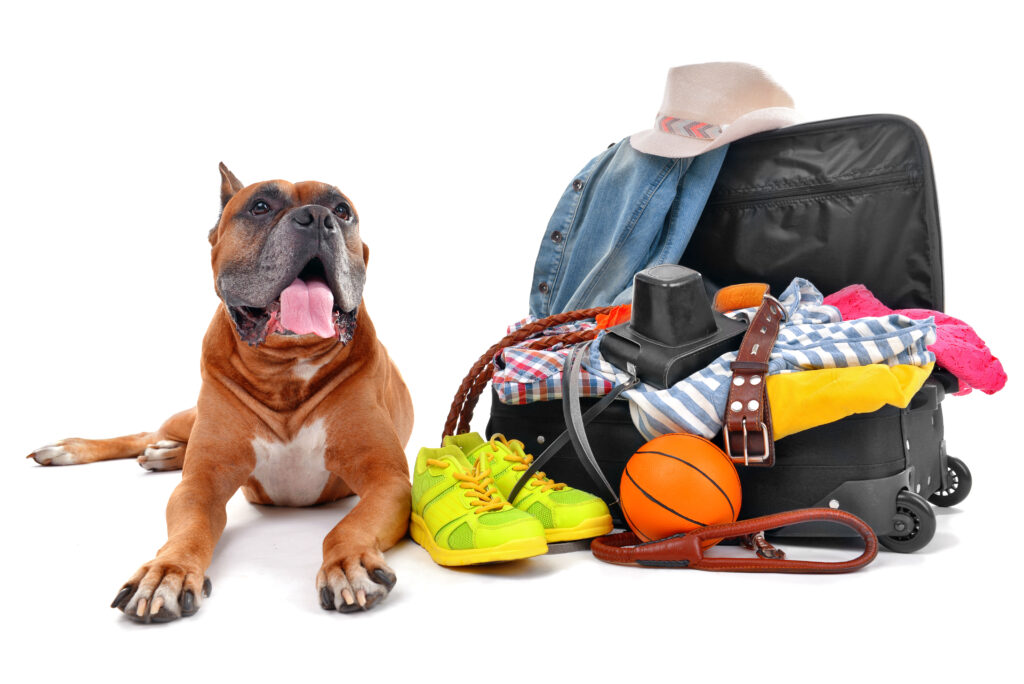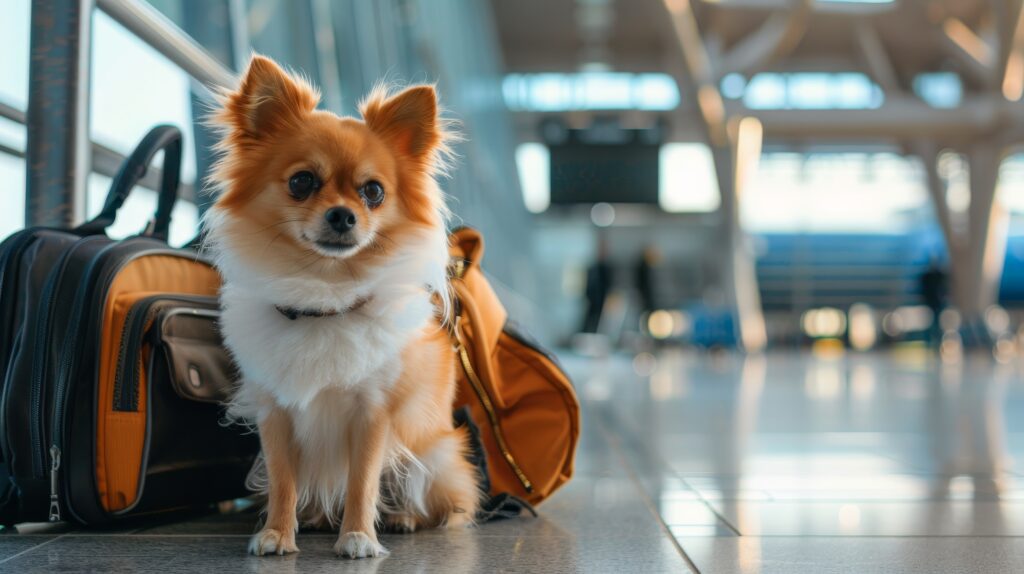
Traveling Abroad with Your Dog: What You Need to Know
Planning to take your dog on an international trip is more than just booking a flight. You need to think about if your dog is ready for the trip. Understanding the rules for traveling overseas with dogs is key. But what does it take to plan for global dog travel and make sure your dog has a good time?
You’ll need to schedule regular vet visits before your trip. You’ll also need to know about vaccine requirements. Airlines have their own rules, and sometimes you need special documents or a health exam. It’s important to know all these things to make sure your pet is ready.
Once you get to your destination, your dog’s routine will need to stay the same. This means bringing their medicine and food. Some places have rules about pets, like on planes or cruise ships. So, planning well is key for a happy trip.
The cost of taking your dog on a trip can be high. But with good planning, you can budget for everything. The best part is, sharing these experiences with your dog is priceless.
Before you pack your dog’s treats and passport, let’s look at the basics of taking your dog abroad. From picking an airline to arriving at your destination, we have the important tips for a smooth trip.
Understanding International Dog Travel Regulations
Traveling with your dog internationally means you need to know about international dog travel regulations. These rules help stop diseases like rabies from spreading. They also keep pets safe during their travels.
Pet passport requirements differ by country. You might need a microchip, a rabies shot, and sometimes boosters. A health certificate from a vet is often needed, and it must be endorsed by groups like the USDA-APHIS. Since April 29, 2020, the USDA has gone fully digital for pet health endorsements through VEHCS.
Knowing about quarantine rules is key. Your pet might have to stay in quarantine if you’re coming from a country not listed as rabies-free. Some places keep pets for a while to check for diseases. Also, pets going to rabies-free countries need a rabies titer test before they can enter.
With so many rules, it’s smart to talk to the embassy of your destination or a pet shipping expert. They know all about international dog travel regulations. They can help with health checks and make sure you have everything you need.
Always look up the latest rules and talk to the right people to get all the details. Doing this makes sure your trip with your dog is fun and follows the law.
Choosing the Right Airline for Your Dog’s Journey
When planning for dog travel abroad, picking the right airline is key. U.S. airline pet policies differ a lot, affecting where your pet will travel. Airlines like Alaska Airlines, American Airlines, and Delta have different prices and rules for pets, from $75 to $200, based on where you’re going.

It’s important to know the risks of cargo travel for pets. For example, JetBlue lets pets stay with you in the cabin. But, Hawaiian Airlines also has cargo options, costing up to $225. Pets with breathing issues might not do well in cargo due to changing temperatures and air quality.
When looking at U.S. airline pet policies, remember the health and safety rules. Some airlines need a vet’s health certificate before you fly. For tips on keeping your pets healthy and meeting airline rules, check out this guide on preventing common dog diseases.
The cost of taking your pet on a trip also varies by airline. American Airlines charges $125 for pets in the U.S. and $200 for international trips. Knowing the costs helps with budgeting, especially when some airlines limit pets per flight, so booking early is a good idea.
Always check if the airline flies directly to your destination to avoid long stops. These stops can stress your pet out. Getting ready for these things makes traveling with your dog smoother, following the best advice in the dog travel abroad guide.
Preparing Your Dog for International Flights
Getting your dog ready for international flights starts early. You need to get a travel certification for dogs, follow ISO microchip standards, and use expert pet travel advice. These steps make the trip easier for you and your pet.

First, talk to a vet to get the right vaccinations and health checks. Your dog needs an ISO-compliant microchip. This is a must in many countries, including the EU. The microchip must meet ISO microchip standards for scanning in different places.
Then, get your dog’s travel certification for dogs. This means an updated health certificate from your vet, endorsed by groups like the USDA-APHIS. You might also need extra papers, like the EU Pet Animal Health Certificate for European countries.
Start crate training early for long flights. Make sure the crate is big enough for your dog to move around. Put in their favorite things like blankets or toys to make it a safe space.
It’s also important to help your dog get used to new places and sounds. This can reduce stress. But, only use sedatives if your vet says it’s okay, as they can affect dogs differently at high altitudes.
Make sure all your dog’s papers, like their travel certification and health documents, are in order. Check they meet your airline and destination’s rules. This detailed pet travel advice helps make the trip safer and more comfortable for your pet.
Navigating Airport Procedures and Pet Export Paperwork
When you take your pet to the airport, you’ll need to follow many steps. This includes getting pet export procedures, animal travel documentation, and an APHIS health certificate. It’s important to know what you need before you go.
First, make sure your pet has all the documents needed for travel. The APHIS health certificate is a key document. It must come from a USDA-approved vet within ten days of your trip. Some countries also need you to get these documents checked at their embassy. So, plan this step early to avoid delays.
Also, each airline has its own rules for pets. You’ll need to know what your airline requires. Airlines usually want pets checked in as cargo and have rules about when you should arrive. Arriving early can make the process smoother.
Getting an APHIS health certificate is important, but it can take time. If you’re going to certain places, you might need to get it checked by your vet or the local consulate. For traveling within the European Union, a pet passport can make things easier.
Handling all the paperwork and rules might seem hard. But, using a professional pet transport company can help. They make sure everything is done right, including following IATA rules for pet crates. This way, your pet will travel safely and comfortably.
To make traveling with your pet easy, plan well. Get your APHIS health certificate early, follow airline rules, and think about using a pet transporter. Knowing about pet export procedures will help you have a smooth trip.

Essential Pet Travel Tips for a Smooth Trip
Traveling with your dog can be an amazing adventure if you plan well. To make sure you both have a good time, follow these tips for traveling with pets internationally. When flying, picking pet-friendly airlines is key. Direct flights are better because they mean less time in the air for your dog. Flying during cooler times also helps keep them comfy.
It’s important to get your pet used to their kennel before you go. Dr. Miller says feed your pet a few hours before flying to help with digestion. Keeping your pet’s shots and health records up to date is also key. This is important for the airline and for the country you’re visiting.
When you arrive, make sure your pet feels safe and comfortable. Bringing a familiar blanket and toy can help, as many pet owners do. Also, remember to pack a collapsible water bowl and extra treats. These items are important for your pet’s comfort, as many travelers have found out.
Planning your trip with your pet in mind makes everything easier. This is what DogHaven suggests for your dog’s health and happiness in new places.





